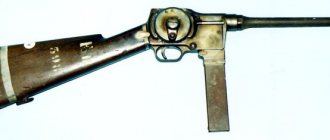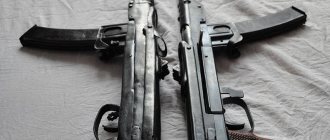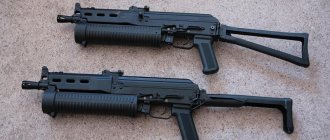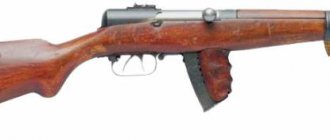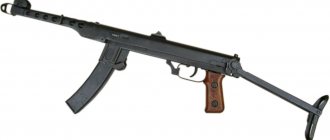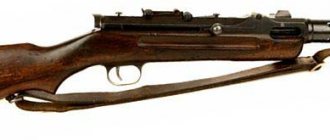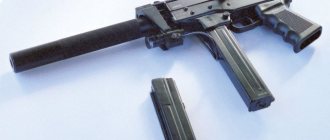Do you think Schmeisser or PPSh is an assault rifle? If we take today's classification of firearms, then neither one nor the other are machine guns. What about the M-16 rifle? Wrong guess again! This is exactly the most automatic machine. What's the difference, you ask? I hasten to satisfy curiosity - the article will explain the difference between an assault rifle and a submachine gun, and at the same time shed some light on the history of their creation.
Submachine gun
This term refers to auxiliary automatic firearms , the ammunition of which is supplied by pistol cartridges. Even today, with the development of the weapons industry, the recruitment of purely PP units is excluded, due to their low penetrating ability. The aimed shooting distance in single mode, even for the best models of this weapon, does not exceed 350-400 meters , and with automatic shooting in short bursts - 200 meters.
Legendary PPSh-41, USSR
But in urban battles, the PP significantly outperforms the rifle in terms of firepower, since its rate of fire can be 300, 600, or even 1000 rounds per minute. Is such a rate of fire necessary? It all depends on the specifics of the battle.
From the history of the creation of a submachine gun
The First World War also received the name trench , since the parties to the conflict, gaining a foothold in positions, organized fortifications, laying kilometers of trench lines. This saved the personnel from enemy bullets and shrapnel. Often people could be on both front lines in the trenches for months.
During the defense of such positions, machine guns . But they turned out to be absolutely useless for those who stormed these positions, due to their cumbersome nature. The same famous Maxim machine gun (this is the one that is “Maximka” in our opinion) when loaded weighed 65 kilograms together with the casing, cartridges and water cooling. His crew consisted of at least two people.
Villar-Perosa M1915, Italy
The idea of making a machine gun lighter came to the minds of inventors in several countries around the same time, but the first prototype of the PP was the Italian Villar-Perosa M1915 - 9x20 mm pistol cartridge . The single-barrel and slightly improved version was called the Beretta M1918.
Submachine guns of the era of change and cartridges for them
Submachine gun: yesterday, today, tomorrow.
Today our story will focus on samples of these weapons that appeared in the late 80s - early 90s of the last century. At this time, the world changed a lot, and weapons were also included in the complex process of change.
Why do you still need a submachine gun?
In the sixties and seventies of the last century, and in some countries a little later, that is, in the eighties, as the NATO bloc actively switched to intermediate 5.56-mm cartridges and weapons corresponding to them, army “universal” SMGs of the previous generation Almost everywhere they were removed from service. Well, if their production continued anywhere, it was only in the “third world” countries, and then mainly because of their cheapness. In NATO countries, the main type of weapon has become an automatic rifle for low-impulse intermediate ammunition, and why this is so clear. For example, it was planned to arm radar personnel with submachine guns. But in the depths of its territory, why arm it with anything at all? And if the enemy lands troops, then, if he were armed with M16 rifles, what kind of resistance would people with submachine guns in their hands be able to offer him? However, they were working on new submachine guns, and in the late 80s and early 90s of the last century they began to appear and brought with them a lot of new things.
In the last decade, the development of submachine guns has made many zigzags, giving rise to many original designs. Here, for example, is a Swedish submachine gun with a blowback bolt running onto the breech, CBJ-MS. It is portable, mobile, but it even has a bipod and a snail magazine!
Look at the photographs of the same airplane pilots: there’s just so much they don’t have, and the pilot in the cockpit of the same attack aircraft or helicopter is so cramped that it’s simply impossible to attach the same submachine gun to him. During the Afghan war, they tried to arm AKS74U pilots and include it in the NAZ... So what? There were four cases of SU7B and MiG-21 pilots ejecting over enemy territory, and none of the pilots were able to use it.
And in terms of size, the AKS74U is approximately equal to any PP, except perhaps the Micro-Uzi. But it is much better both in terms of effective range and penetration power. The barrel of the AKS74U overheats only from the fourth magazine when firing at a fast pace, but how long will the same pilot keep it going? And it’s not for nothing that the tank also provides storage for both machine guns and hand grenades. After all, tankers will have to deal with an enemy armed not with submachine guns if their combat vehicle is destroyed. Hence the need, again, for fire of adequate strength and accuracy on their part.
The main weapon of anti-terrorism!
However, at the same time, namely the sixties and seventies of the 20th century, a new round in the development of submachine guns as a type of weapon began in the West.
True, now at a fundamentally new level. Now it has again become a police weapon, as they talked about it back in the 30s, but not for the entire police force, but for special forces and various intelligence services. It turned out that ordinary police could not effectively fight international terrorism and organized crime and they needed an adequate response and adequate weapons. After all, none of the same terrorists will run around the city with an M16 rifle, but will choose something more compact and less noticeable. This means that the same weapons, but of better quality, should be used against them. And the German Heckler & Koch MP5 became a typical weapon for counter-terrorism operations. And, yes, it really looks more like an assault rifle (after all, it was created on the basis of the G3 rifle), and in size and weight it is closest to the MP40 or PPS, that is, weapons of a previous era that have stood the test of time. But “closer” does not mean “exactly”. The designs of new PCBs are much more complex and advanced. They began to use semi-free bolts, or even exhaust gases for automatic operation, firing “from a closed bolt” when using trigger triggers - all this increased the quality of the new generation SMGs by an order of magnitude in all their characteristics.
"Russian Forest" - submachine gun "Kedr"
And this is “Kedr” and its shops...
But in the regular army, PP at that time were used very limitedly, first of all, as a traditional weapon, and one might even say: as a “psychological” and “status” weapon to arm artillery soldiers, tank crews, signalmen, missilemen and staff officers. That is, all those for whom fire contact with the enemy under normal conditions is theoretically possible, but the practical risk of which is reduced to the very minimum.
Another sample from the “Russian forest”: OTs-02 “Cypress”
New time - new songs!
It is interesting that in our country, the USSR in the 70s of the twentieth century, apparently under the impression of the success of the Mini-Uzi and Ingram, announced a competition for the development of a 9-mm submachine gun for sabotage purposes, in which such famous designers as N. M. Afanasyev from Tula and E. F. Dragunov from Izhevsk.
But our 9mm cartridge turned out to be too weak. It gave an effective firing range of only 50-70 meters, which could not be considered satisfactory. Therefore, work in this direction was then stopped. But under the motto “Modern” they tried to create a new 5.45-mm small-sized machine gun, in order to again arm artillerymen, crews of armored vehicles and soldiers of auxiliary units with this weapon. The winner was the Kalashnikov assault rifle, familiar to both the military and industry - AKS74U. But as soon as the “winds of change” began to blow in our country in the eighties and nineties of the last century, interest in PP was fully awakened and new samples began to appear like mushrooms after rain. First of all, they were in demand as “police” and, of course, counter-terrorist weapons. Old drawings were taken out of the archives and a whole series of designs from the seventies were quickly brought to mass production: a whole “tree nursery” “Chestnut” (see VO February 3, 2015), “Cypress” and “Cedar” (see VO October 2, 2013 .). And many more designs for special forces and police were created from scratch: PP-19 “Bison”, “Gepard”, OTs-22, SR-2, PP-90, PP-90M1, PP-2000 and many others. And today we can see them in the hands of the traffic police, and collectors, and... in one word, “ours was found.” Now we would like to create something equal to the Kalashnikov to enter the world PP market, but so far this has not been achieved.
Our “Bison” turned out to be especially interesting - outwardly a copy of a Kalashnikov assault rifle, but chambered for a pistol cartridge and with a large-capacity auger magazine.
It can accommodate folding stocks of various devices...
... and the Bison can also be equipped with a muffler.
Here we need to again turn to theory and find out what, in fact, the customers of new submachine guns want from their creators, and again, what trends both are following today. Or rather, they began to follow such an epoch-making event as 1991 and the collapse of the USSR. And it so happened that the spread of body armor even then greatly reduced the combat value of submachine guns, which fired standard pistol cartridges with their specific bullet shape and low effect on obstacles. And this led to the fact that the very idea of a submachine gun as a small weapon chambered for conventional pistol cartridges had to be reconsidered. To solve new problems, special, let’s say “submachine gun”, and very specific ammunition was required. The easiest way was to create small-caliber, low-pulse cartridges.
The American American-180 is a deadly little thing.
Which is better: one big bullet or many small ones?
In addition, it turned out that at a rate of fire of about 20 rounds per second, the number of hits in the same place on the target greatly increases the armor penetration of such small-caliber bullets, since the armor of the plates of bulletproof vests simply does not have time to restore its microcrystalline structure after many successive hits and is destroyed. So, for example, submachine guns such as the American-180 and its improved analogue, the Yugoslav Gorenje MGV-176 (caliber 5.6 mm or .22LR), immediately became profitable. A new concept also appeared, called PDW (English: Personal defense weapon - “Personal self-defense weapon”), the essence of which was to create new cartridges and, for them, new types of PP. This is how, in fact, the fourth generation submachine guns appeared.
Yugoslav MGV-176.
The new ammunition has become something of a cross between pistol and intermediate cartridges for machine guns, but still closer to the former, primarily in such indicators as power and recoil energy. But the use of sharp-nosed small-caliber bullets in them at ranges of up to 150-200 m in terms of impact on the target made it possible to achieve results comparable to intermediate ones. First of all, thanks to the high initial speed and flat trajectory of the bullet, it was possible to significantly increase their penetrating effect. One might even say that in this way another fundamentally new type of small arms was born.
And this is nothing more than... a “whale” - that is, a set of devices that allows you to assemble another from one. In this case, this is a set of additional parts for the Glock-17 pistol, which allows you to easily turn it into a submachine gun!
Another Glock conversion, and you can’t even tell which one is “cooler”!
However, in NATO countries, design work within the framework of the CRISAT (Collaborative Research Into Small Arms Technology) project began back in 1990, and their goal was extremely important and significant: to find a replacement for the legendary pistol cartridge 9x19 mm "Parabellum". At the same time, it was necessary to create two new models for the new cartridge: a pistol weighing up to 1 kg and a submachine gun within the framework of the PDW concept with a weight of up to 3 kg. The pistol bullet had to pierce a 1.6 mm thick titanium plate or 20 layers of Kevlar fabric, and hit the enemy behind these barriers at a distance of up to 50 m. The submachine gun had to do the same thing, but at a distance of up to 150 m.
The very short MP5 is more of a fashion statement than a truly serious PDW weapon.
Submachine guns chambered for “small cartridges”
Interestingly, this year was also marked by the appearance in Belgium of the first “weapon-cartridge” complex, which consisted of a new 5.7x28 mm ammunition, an FN “Five-Seven” pistol and a submachine gun in the PDW concept - the FN P90 from FN Herstal. Let us remember that thanks to its original cartridge, more similar to a machine gun than a pistol, it was possible to squeeze as many as 50 such ammunition into its magazine. Its cartridge case is bottle-shaped and quite long, which also made it possible to place a powerful powder charge in it, the ignition of which causes its pointed bullet weighing 1.8 g to leave the barrel with a speed of 823 m/s and an energy of 610 J. At the same time, the low mass of the bullet made it possible reduce recoil compared to traditional 9x19mm cartridges.
MP7 submachine gun.
However, it is worth noting that despite all the positive aspects, the P90 did not become widespread as an army self-defense weapon, but again ended up in the arsenals of special police forces. That is, the original idea of PDW was corrected by life, and there is nothing surprising in this, it happens all the time. They even wanted to adopt the Belgian 5.7 mm cartridge as a standard one for NATO, but then it had a competitor from Germany, the 4.6×30 mm cartridge created in the late 1990s. It was made by the same company, and they released an MP7 submachine gun for it (see VO October 9, 2010) and a HK P46 pistol. Its data is as follows: energy 460 J (since the caliber is smaller), bullet mass 1.7 g, and also less initial speed - 736 m/s. But with all this, its penetration characteristics are quite comparable to the Belgian. Well, in the submachine gun the automatic gas system from the G36 rifle was used.
Bundeswehr MP7A1 submachine gun with Zeiss collimator sight and LLM01 laser designator.
On tests 2000-2003. The Belgian 5.7 mm cartridge showed itself to be better than the German one. But it was never possible to standardize it for NATO, and each country remained with its own interest.
Meanwhile, a new cartridge with similar parameters was created by Vlastimil Libra (owner of a private arms company) in the Czech Republic. The cartridge is called .17 Libra and has the following dimensions: 4.38x30 mm. The bullet for it is very light and easily reaches a speed of about 700 m/s, which allows it to penetrate standard NATO body armor at a distance of up to 250 meters. It penetrates a 10-mm steel plate at a distance of 10 m, and maintains a very high stopping effect up to 200 m. The CZW 438 submachine gun was created for the new cartridge.
Submachine gun CZW 438.
The Chinese are not far behind, who already in the mid-90s created the 5.8x21 mm cartridge, and made the Chang Feng submachine guns for it (see VO February 22, 2022) and Type 05. This cartridge has and a rather heavy bullet (weighs about 3 grams), with a high initial speed - up to 500 m/s. It is interesting that the magazine of this submachine gun is auger, but unlike our “Bison” it is located not from below, but from above the receiver!
“Bad examples” are contagious (just kidding!), and in Sweden they also decided to make a similar small-caliber armor-piercing ammunition for a submachine gun and made a 6.5x25 mm cartridge with a tungsten bullet in a plastic pan. And in the early 2000s, a CBJ-MS submachine gun was also made for it (see VO March 5, 2013), which has a tungsten sub-caliber bullet in a plastic tray. This bullet is the fastest. Its initial speed is at the level of the Mosin three-line gun - 830 m/s, so it is not surprising that at a distance of 50 m it can freely penetrate 7 mm armor plate. Moreover, this ammunition is designed on the basis of a cartridge case from the 9x19 “Parabellum” cartridge, slightly elongated and with a barrel for a 6.5 mm caliber. That is, in terms of external dimensions, it is essentially unified with the 9x19 cartridge, which is very convenient, since it makes it possible to use it in existing weapons chambered for this cartridge. Only the barrel needs to be replaced, that's all! You don't even need to change the shutter!
Submachine gun CBJ-MS.
True, there are spots in the sun too. Although it has an impressive firing range, up to 200-250 m, its bullet has a weak stopping effect. Nevertheless, this is a very interesting example of a submachine gun and it will be interesting to see how its fate will turn out.
And then it happened that in 2008, the NATO leadership decided, firstly, to develop separate specifications for “soft” and ceramic plate-reinforced body armor, and secondly, to create a new “assault rifle for everyone.” So today all efforts are being devoted to this, and submachine guns have again faded into the background.
To be continued…
The German way of thinking about PP
Designers from Germany saw the PP as something superior in firepower to a pistol, but essentially a heavier version of it. For these purposes, large-capacity magazines and stocks were attached of the Luger and Mauser C96 They tried to adapt them for burst fire. The test results were unsatisfactory. Ultimately, a hybrid carbine, machine gun and pistol was created, called the MP-18/I. He showed himself very well when storming the trenches. Soldiers armed with rifles and pistols had virtually no chance in close combat against soldiers with SMGs.
American concept
Thompson PP, USA
In the USA, they approached the issue slightly differently - in their understanding, the PP was a lightweight version of a machine gun, and not a heavy automatic pistol. This was the brainchild of General Thompson , which was published in 1916-1919. He did not have time to take part in the First World War, but in the post-war years he enjoyed wild popularity both among law enforcement officers and in criminal circles. The Tommy Gun 45- pistol cartridges . It is the Thompson PP that takes precedence in the sense that weapons of this class began to be called Submachine gun , that is, a light machine gun.
What is an automatic then?
The confusion in terminology, which persists today, is due to the fact that in the USSR all submachine guns were called machine guns until the appearance of the legendary AK-47 .
Since then, a machine gun has been called a personal small weapon that allows automatic fire, chambered in an intermediate or rifle cartridge. In the Soviet Union, it was developed in 1943 by N.M. Elizarov and B.V. Semin , its caliber was 7.62x39 mm . The machine gun is characterized by light weight (3-5 kg), relatively compact dimensions and a fairly capacious interchangeable magazine.
Abroad, the same class of weapons is called an assault rifle (English assault rifle , German Sturmgewehr ).
Sturmgewehr-44, Germany
The mission of assault rifles and SMGs is largely similar, and for the most part both are designed for close-range combat. However, due to the use of more powerful ammunition, a bullet fired from a machine gun can retain its destructive power even after a kilometer of flight, and the effective firing range of single shots significantly exceeds the capabilities of even the best SMGs.
Automatic or assault rifle?
Regarding small arms, the term “machine gun” was first introduced in our country in the 1920s by the head of the officer courses “Vystrel” Filatov in relation to the Fedorov submachine gun (automatic rifle) of the 1916 model. Subsequently, the term was officially enshrined in terminology and is now according to GOST “Small arms. Terms and definitions "the term machine gun stands for "automated carbine", in other words, a compact hand-held individual weapon with a rifled barrel, capable of automatic firing.
It should be borne in mind that this term includes not only the usual assault rifles chambered for a transitional cartridge (for example, Kalashnikov assault rifles, silent AS Val, SR3M Vikhr assault rifles, compact AM-17 and AMB-17, and so on ), but also submachine guns. In fact, the aforementioned GOST deciphers the term “submachine gun” as “an assault rifle chambered for a pistol cartridge.” Based on this, in the domestic specification, Western weapons chambered for intermediate cartridges, for example, the German G36, the Belgian FN SCAR-16, the Chinese Type 95 or the Japanese Type 89 are also considered machine guns. An interesting terminological situation arises with American weapons - after all, if we proceed from our formal definition of an assault rifle as an “automated carbine,” then only the automated M4 carbine is considered a “real” assault rifle, while the M16 automatic rifle, on the basis of which it was created, is, as it were, no longer “automatic”. However, this curiosity is just an example of the fact that any formal terminology usually does not keep up with the real world and always allows exceptions to the rules. What is an assault rifle?
The term “assault rifle”, which came into Russian weapons terminology in the form of a tracing-paper from the German term Sturmgewehr and the English Assault rifle. In most cases, it is believed that the author of this term is Adolf Hitler, who in the first half of the 40s of the twentieth century named an automated carbine chambered for a transitional cartridge (a rifle cartridge of reduced power) as an “assault rifle” from propaganda ideas.
However, both the basic idea and the term “assault rifle” itself are actually much older, and date back to the First World War. Without going into the history of the concept, it should be noted that this term in post-war world practice was used haphazardly, and there is no single definition of what an “assault rifle” is. It is classically believed that this term means an individual hand-held automatic weapon chambered for a transitional cartridge, because this is what the first global “Sturmgever” actually was. But in reality, in the fifties and sixties, several types of automated rifles chambered for powerful rifle cartridges, absolutely officially called “Stormgewehrs”, were created and put into service in the world, primarily about the Belgian FN FAL rifle of 7.62x51 NATO caliber, in the second half of the 50s years of the twentieth century, adopted by the Austrian army under the symbol Stg.58, and about the Swiss automatic rifle SIG 510 caliber 7.5x55, which was in service with the Swiss army under the symbol Stgw.57. A special ridicule here is that these two “assault rifles” were in service with the armies of neutral states with a strictly defensive doctrine. At the same time, in many armies of the world it was absolutely reasonable to think that a rifle is a rifle, and all the same weapons can be used not only for assault, but also for defense, guard duty or parades, and therefore call their own standard models without additional definitions, for example “Rifle, 5.56mm M16A2” or “7.62mm Gewehr 3A2”. In general, with a certain imperfection of terminology, variants of which are given above, the domestic term “machine gun” has much more rights to exist than the notorious “assault rifle”.
Brief historical excursion
The designers really began creating machine guns during the Second World War , since automatic rifles with a powerful cartridge did not meet the requirements put forward for them - low recoil, weight and dimensions, low cost and manufacturability in production. Light machine guns, on the other hand, although they were more or less compact, firing from them meant installing, for example, a bipod on a support, which greatly reduced the maneuverability of the shooter.
M1 carbine, USA
The empty niche between the automatic rifle and the submachine gun was occupied by the machine gun. The first truly serious development for the 7.92x33 mm kurz intermediate cartridge was SturmGewehr-44 . to talk about the American M1 Carbine .30 caliber as an assault rifle, due to the fact that the ammunition for it simply did not reach the required level in terms of its characteristics, but was typical of pistol ammunition both in terms of penetrating power and firing range.
It was on the basis of these two models that the legendary AK-47 was developed, which gradually replaced the Mosin rifle, PPSh, PPS, SVT, and other types of small arms. But that is another story.
Comparison
Judging by the external differences, a machine gun is larger and heavier than a machine gun, in most cases it has a significantly longer barrel and magazine capacity for ammunition, and has a bipod or machine.
The AK-47 machine gun is in most cases equipped with additional mechanisms for ease of aiming, which the machine gun does not have. The caliber of many machine guns exceeds the caliber of machine guns.
Because of these and other features, a machine gun is capable of shooting even further than a machine gun, and more accurately (at long distances). The purpose of these types of weapons is also uneven: a machine gun is an individual weapon, which is intended for attack and the personal safety of an individual soldier, and a machine gun is used as an excellent means of supporting infantry actions in battle. Likewise, the machine gun is a group weapon. The range of use of machine guns is wider than that of machine guns. They come in hand-held, easel, aviation, large-caliber, and tank types.


